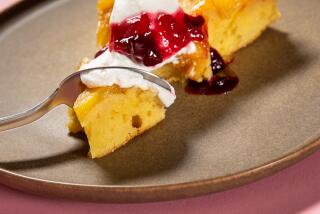Gardening : No Hedging: Pineapple Guava Rates Best
- Share via
If asked to name the most rewarding shrub in my yard, I could give an instant answer--the pineapple guava. It is a beautiful evergreen shrub that bears delectable fruit and makes a marvelous privacy hedge because it can be pruned radically. And best of all, once established, it thrives on neglect.
The pineapple guava, Feijos sellowiana , is not a true guava and will tolerate much harsher climatic conditions than its namesake. It is widely adapted to Southern California climatic zones. Its ability to survive a temperature range of 10 degrees to 110 degrees makes the pineapple guava the hardiest of the subtropical fruits.
Well Received
In the last few years, the fruit of the pineapple guava has made an appearance in specialty produce markets where it is sold as feijoa and has been well received by shoppers. A recent issue of California Grower reports that commercial plantings of the fruit are occurring at various locations around the state.
If you’ve never sampled the grayish-green fruit of the pineapple guava, it has amber-colored flesh that is aromatic and juicy. The flavor might be described as pineapple-like, with papaya overtones. It is delightful for eating fresh; simply slice the fruit open and use a spoon to scoop out the flesh. The fruit also makes marvelous jellies and jams.
The shrub itself has glossy medium-green to gray-green leaves, which are silvery-white underneath. From a distance, the coloring would be similar to an olive tree. It blooms in May or June and produces exotic blossoms with large, white, fleshy petals that feature brilliant red stamens covered with golden pollen. The sweet petals are edible and lend a gourmet touch to salads. The fruit are egg-shaped and range in length from 1 to 4 inches and are usually borne in huge quantities. They ripen five to six months after blossoming and drop to the ground when fully ripe.
The shrub offers many options as to training. It may be shaped to a small, multitrunk patio tree or a thick privacy hedge, a background shrub or espalier plant. If left unpruned, the pineapple guava will obtain a height of 15 to 20 feet; however, it can be maintained as low as 3 or 4 feet. Pruning should occur in late winter but it may be trimmed at any time.
The pineapple guava likes a sunny location but will tolerate partial shading. As to soil, it will thrive in a good, well-drained soil, but it also will make acceptable growth in all but the most soggy of soils.
Pineapple guavas should be grown from container plants. There are a number of varieties, some of which require cross-pollination with another cultivar and some of which are self-fruitful.
Coolidge is the most widely available variety. It does not require another variety as a pollinizer and produces heavy crops of small fruit. Nazemetz produces large fruit of superior flavor. It is also self-fruitful. Trask produces large fruit of fine flavor and is sterile without a pollinizer. Nazemetz makes a good pollinizer for Trask. Pineapple Gem is a reliable producer of smaller, tasty fruit.
The plants should be planted 2 to 4 feet apart if utilized for a small hedge or 4 to 6 feet apart if grown as a large privacy screen or planted individually as a small tree. Set the plants at the same level they were in the nursery container. A light application of a timed-release fertilizer at the time of planting will help get them off to a fast start.
Health Shrubs
Water during the transplanting process and then two times a week for the first six weeks. Water deeply on a 7- to 10-day schedule, depending upon water-holding capabilities of your soil. In a couple of years, when the shrubs become well-established, a deep monthly watering will suffice. The pineapple guava has amazing drought-tolerance capabilities and, when an older plant’s roots reach deeply in the soil, it can go for extended periods without irrigation; however, this isn’t a good practice.
Fertilize in early spring with a general-purpose fruit tree fertilizer or slow-release fertilizer tablets. The pineapple guava is almost pest-free and requires no insect control.
The fruit should be allowed to ripen on the plant and drop to the ground when fully ripe. Gather the fruit from the ground and refrigerate to avoid spoilage. If planted in desert areas, the pineapple guava may not produce fruit.






